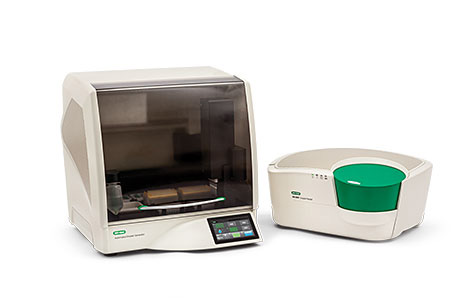The Bio-Rad Droplet Digital PCR Publications Database
An extensive catalog of published research enabled by Bio-Rad’s ddPCR technology
The introduction of digital PCR (dPCR) represented a paradigm shift in the field of quantitative polymerase chain reaction technology. Bio-Rad brought digital PCR to another level with the introduction of the revolutionary Droplet Digital PCR (ddPCR) technology. This technology - which enables large-scale dPCR analysis of nucleic acid targets in discrete, volumetrically defined water-oil droplet partitions - represents a scalable, practical solution for dPCR implementation. Today, with more than 6000 published studies and growing, nowhere is the power of Droplet Digital PCR technology further apparent than Bio-Rad’s expansive ddPCR Publications Database.
Background of digital PCR
ddPCR technology is based on the concepts of digital PCR analysis and absolute quantification. A critical step in digital PCR, and a major departure from conventional PCR, is sample partitioning -- the division of each sample into discrete subunits prior to PCR amplification.
Following standard PCR setup procedures, the reaction sample is separated into thousands of partitions, each ideally containing a single DNA template. Following PCR amplification, each partition is quantified as either having the target sequence or not, either a positive (1) or a negative (0) result. The ratio of the number of negative partitions to the total number of partitions in each analyzed sample then forms the basis for quantification – which relies on Poisson statistics, rather than typical methods of counting PCR cycle numbers and estimating target abundance.
Major practical advantages of digital PCR include higher sensitivity and precision, for the detection of small amounts or rare frequencies of target sequences in DNA samples. These advantages enable analyses of copy number variations (CNVs), rare mutation detection, single-nucleotide polymorphisms (SNPs), and gene expression of rare targets -- features implicated in complex processes and genetic diseases.
Advantages of Droplet Digital PCR (ddPCR) technology
The Bio-Rad Droplet Digital PCR technology delivers higher levels of performance, throughput, and scale than standard dPCR. Using a unique water-oil emulsion droplet and microfluidic technology, the ddPCR system fractionates DNA samples into 20,000 nanoliter sized droplets. PCR amplification followed by digital detection methods results in precise, absolute quantification.

Benefits of Droplet Digital PCR over previous techniques include:
- Unparalleled Precision – the massive sample portioning afforded by ddPCR enables reliable measurement of small fold difference in target DNA sequence between samples.
- Increased signal-to-noise – enrichment for rare targets results from reduced competition with high-copy templates.
- Removal of PCR efficiency bias – error rates are reduced by removing the amplification efficiency reliance of PCR, enabling accurate quantification of targets.
- Simplified quantification – standard curves are not a requirement for absolute quantification.
The growing database of ddPCR applications and published research studies
The Bio-Rad ddPCR system - QX200 ddPCR System, with paired reagents, consumables, and hardware – has gained prominence by enabling applications ranging from basic molecular genetic research to large-scale clinical investigations. The Bio-Rad ddPCR Publications Database is a central repository for published research, serving as a testament to the impact of ddPCR on scientific inquiry and progress. The number of publications in the database currently rests at 4400 - a number that is steadily growing - and a brief review reveals the vast diversity and scope of research enabled by ddPCR technology.
Genetic variation in human DNA replication timing
Cell. 2014 Nov 20; 159(5): 1015–1026
This study - which involved investigators from Harvard Medical School, the Broad Institute of MIT, and other high-profile research centers - is an illustration of the power of ddPCR technology in helping to drive research relevant to cancer genetics, diagnostics, and other important fields.
The objective of the study was to explore the temporal order of DNA replication and its impact on the distribution of mutations along the human genome. A genome-wide association study (GWAS) identified “replication timing quantitative trait loci” or rtQTLs, which correlated with allele-specific timing and gene expression variation.
The ddPCR technology served as an important tool for assaying multiple rtQTLs within a sample of the GWAS cohort. In this capacity, ddPCR enabled determination of statistical significance and supported the overall conclusion that inherited genetic polymorphisms regulate, not only timing of DNA replication, but the mutability of nearby sequences.
Non-invasive prenatal diagnosis of paternally inherited disorders from maternal plasma: detection of NF1 and CFTR mutations using droplet digital PCR
Clin Chem Lab Med. 2018 Apr 25; 56(5): 728-738
The objective of this study was to develop a liquid biopsy protocol for non-invasive prenatal diagnosis using Droplet Digital PCR. Such a diagnostic could potentially detect inherited mutations by a prenatal screen of maternal blood – thereby limiting the serious risks associated with current invasive screening techniques.
The ddPCR technique and specific hydrolysis probes were used to successfully detect paternal mutations and fetal genotypes in plasma samples. The experimental results indicated highly accurate test methods for detection of NF1 (neurofibromatosis) and CFTR (cystic fibrosis) mutations in cell-free fetal DNA.
This study offers important proof-of-principle that ddPCR is a viable platform for prenatal screening diagnostics – tests that can be implemented in clinical genetics labs and possibly extended to many other monogenetic diseases. Furthermore, the work demonstrates the capabilities of ddPCR, not only as a research tool, but as a primary platform for clinical diagnostics.
Conclusion
As an enabling platform, ddPCR has created a new portal into high-resolution genetic and genomic analysis and has introduced a fresh perspective on disease research. The ddPCR Publications Database is an important resource serving as a powerful testament to the value of this breakthrough technology. The ddPCR technology will continue to have an important impact on research, with potential implications on human health and medicine - all documented through the growing ddPCR Publications Database.
This article was written by LabX and published in partnership with Bio-Rad Laboratories Inc.
Updated February 2022










